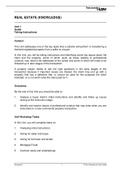Lecture notes
LPC Real Estate Law and Practice ULaw Notes - Includes Workshop Recaps (Complete Units 1 - 15) - DISTINCTION
- Module
- Real Estate
- Institution
- University Of Law (ULaw)
University of Law LPC Real Estate Law and Practice Notes for Units 1 - 15. This includes FULL comprehensive completed workshop notes for the entire module, which includes answers for the preparatory tasks and the in-workshop tasks, that will leave you 100% ready for your workshops, learning and...
[Show more]












